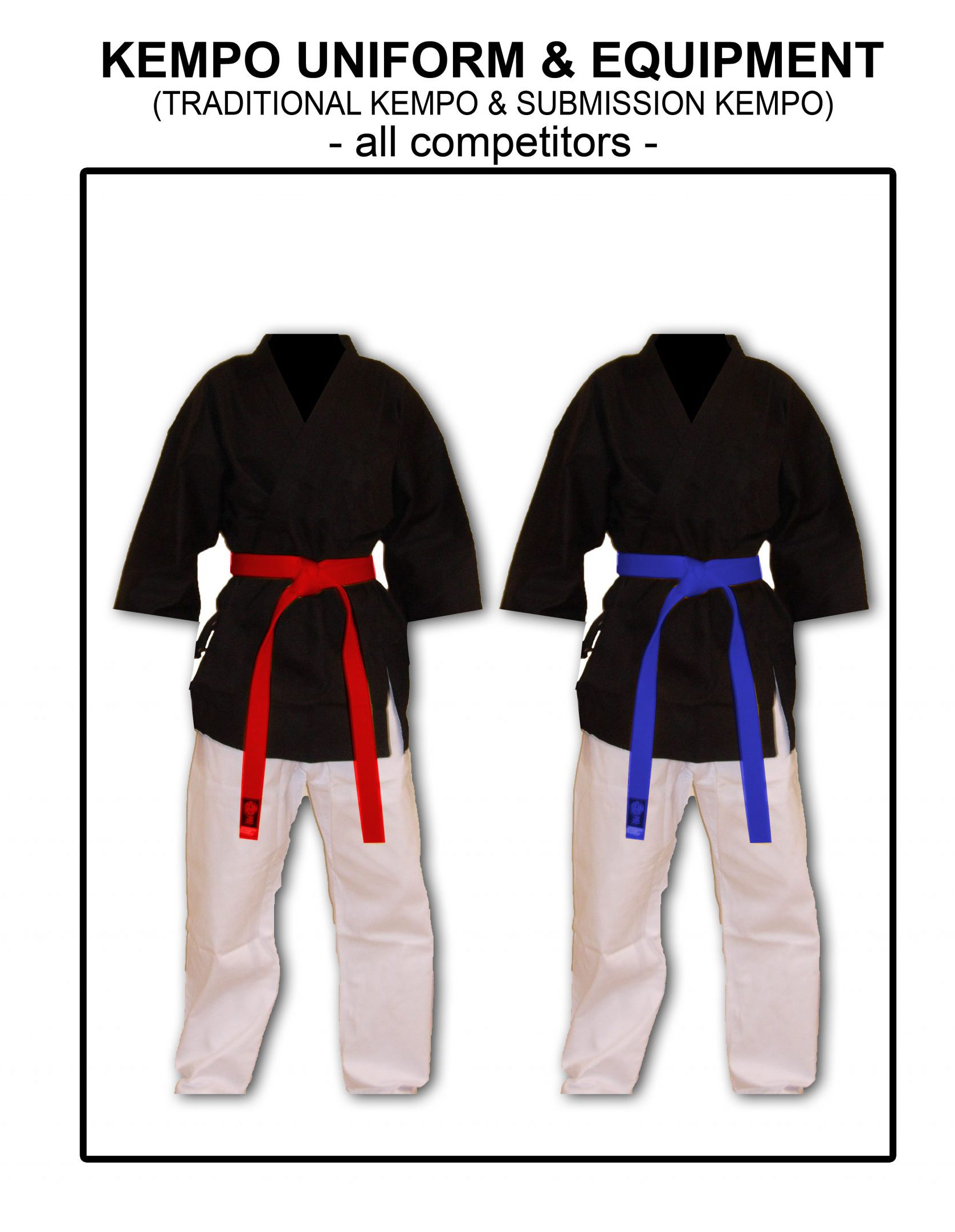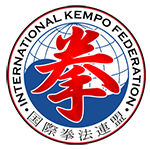KATA
(FORMS/EMPTY HANDS)
Attention!
KATA rules must be organized obligatory in all National Cups and Championships, Continental Cups and Championships, World Cups and Championships, and Adaptado Championships.
By IKF decision, these rules can be organized for individuals or/and teams championships as well.
All IKF members will update their constitutions and will apply these rules accordingly in their countries.
In the KATA division, a competitor or a team shows their skills about a particular Kempo Kata of their choice. A Kempo Kata means a traditional Kempo Kata as well as a modern Kempo Kata.
- All IKF Kata have a purpose, they are for defending, attacking, balance, developing muscles, or breathing purposes. An IKF Kata is not a dance, and it must have a combat value.
- Inside the KATA division there are 2 subdivisions :
1. KATA INDIVIDUAL ( one single competitor )
2. KATA SYNCHRONIC ( one team composed of 3 competitors ) - All competitors or teams will wear the Red Belt / Blue belt, depending on their corner.
Age categories in KATA
- 8-10 years old (8 and 9 years old)
- 10-12 years old (10 and 12 years old)
- 12-14 years old (12 and 13 years old)
- 14-16 years old (14 and 15 years old)
- 16-18 years old (16 and 17 years old)
- Seniors B: 18-21 years old (18, 19, and 21 years old)
- Seniors A: 21-37 years old
- Seniors-Masters: +37 years old (over 37 years old
Note: a KATA team will be composed only of athletes from the same age category; in KATA or KATA SYNCHRONIC if there will be less than 3 countries per category, they will be moved and merged directly to the next age category.
Presentation in KATA
- when the specified category will be called, all competitors from that category will take place on the chairs in the back of the competition area; they will not leave their chairs until the announcement of the head referee.
- when their turn comes, the competitors have to enter the tatami at the head referee’s announcement, and start their presentation as follows: competitors walk in front of the head referee, salutes, and speaks out loud as follows:
For individual kata: NAME – COUNTRY – KATA (Example: Robert Zingg – USA – Seiyuchin)
For synchronic kata: COUNTRY – TEAM Nr. – KATA (Example: USA – Team 1 – Seiyuchin)
- competitors will start their performance after the signal of the head referee.
- at the end of their performance, competitors will salute the head referee again, waiting for the decision decently.
The time limit in KATA
- the maximum time is 3 minutes.
- the time will start from the salute for starting to perform until the salute at the end of the performance.
- if the time limit will be overlap, the scorekeeper will give the sign “TIME OVERLAP” to the head referee.
- the head referee will inform after finish the performance, the competitor or team, and the audients that the time limit is overlapped.
- if the time it was overlap, the head referee will disqualify the competitor or team.
How to win
- the decision will be taken by the majority of referees.
- in KATA competition there will be always one competitor competing against another competitor, or one team competing against another team.
- the winner will go forward in the next round, the loser is eliminated.
- the last 4 competitors or teams will compete for places 1st to 4th.
Refereeing and Judgments
- the refereeing system within the International Kempo Federation is by having 3-5 referees.
- the referee team is separated into one head referee and 2 or 4 site referees.
- in the semi-finals, there are 3 referees from different countries.
- in the finals, there are 3 or 5 referees depending on the organizer staff of the IKF.
- the decision will be taken directly by the referees as follows: the side referees and the head referee will watch in the same direction and they will show the winner of them directly by their blue or red stick, at once, at the sign of the head referee.
- the decision will be taken by the majority of referees.
- a referee who was not present in the referee course on the day before the competition will be not allowed to act as referee in that event.
- the following principles are very important if we have to judge a performance in KATA.
- every referee must have the knowledge and must be able to give the right interpretation of upper rules.
The 7 PRINCIPLES of KATA
- KATA and WEAPON KATA has to be alive and has to carry out with feeling. It must be clear what the techniques are for, by getting them a combat value. A KATA must be not just like “a dance”, nice for looking, having not a combat value of techniques.
- There has to be “spirit”. Energy, force, and mind must come together at one point in a short moment. Here we can talk about “Focus”.
- The power of strong and weak, hard and soft, flex, and relax. This we have to see in a KATA.
- The timing of fast and slow. There has to be a variation in speed. There is a difference between action and no action in a KATA. In this manner, there will be a rhythm in the also by getting a character and a feeling of a battle.
- Rhythm of breathing, the right way of breathing in and out. Gather power and energy in the area of our energy-center in the lower abdomen.
- Balance is in every exercise very important. For right and effective techniques it’s important to have a good balance of the body. Some techniques in a KATA are just for the development of the balance of the body.
- Synchronization is very important in KATA SYNCHRONIC.
Note: Referees /judges must have always in their mind the following questions in order to judge correctly :
1. How was the PRESENTATION?
2. How was the SYNCHRONIZATION?
3. How was his attitude? Did he looks like a fighter or was his attitude weak during the whole presentation?
4. How was his BREATHING? It was good? It was not good?
5. How was his BALANCE? Did he lose his balance during the performance? He was strong on his legs?
6. How it was applied HARD/SOFT, the main principle of Kempo? It was just Soft movements? It was just HARD movements?
7. How was his KIME? Did he show he is a fighter by his attitude? Did he look like having a real fight, a real battle during his KATA? Did he induct you the feeling that something strong and focused was inside of his performance, or did his movements look just like a dance, just like a beautiful succession of movements and that’s it?
Disqualification in KATA
- if one competitor/team is not coming to compete after 30 seconds follows disqualification.
- when a competitor or team stops the performance before the end, disqualification will follow.
- when a competitor or a member of a team moves out of the competition area, the competitor or the team will be disqualified.
- when performance is more than the time limit.
KATA SYNCHRON
– Page Under Construction –
We apologise for any inconvenience caused during these construction works safety sign notice.
KATA – official list
*Note: This list will be upgraded with all Kata received from the new IKF-members. Despite this list, all competitors are allowed to perform their specific Kata at their discretion.
| KATA (Forms) | |||
| Name | Country | ||
| Bagatur | Bulgaria | ||
| Chinto | USA | ||
| Gojushiho | USA | ||
| Jion | USA | ||
| Jitte | USA | ||
| Kaneshima no Forms | USA | ||
| Kanshiwa | Holland | ||
| Krut | Bulgaria | ||
| Kube – Tar | Bulgaria | ||
| Kusanku | USA | ||
| Nihanchi Nidan | USA | ||
| Nihanchi Sandan | USA | ||
| Nihanchi Shodan | USA | ||
| Pasai | USA | ||
| Pinan Godan | USA | ||
| Pinan Nidan | USA | ||
| Pinan Sandan | USA | ||
| Pinan Shodan | USA | ||
| Pinan Yondan | USA | ||
| Rohai | Romania, Holland | ||
| Sabia | Bulgaria | ||
| Saifa Godan | Holland | ||
| Sanchin | Holland | ||
| Seisan | USA | ||
| Seiyunchin | Romania, Holland | ||
| Seu Sai Iki Eku no Forms | Holland | ||
| Shaolin Chuan Fa | Holland | ||
| Slava | Bulgaria | ||
| Striag | Bulgaria | ||
| Tangra | Bulgaria | ||
| Toraken-ryu Ni-dan Ichi | USA | ||
| Toraken-ryu Ni-dan Ni | USA | ||
| Toraken-ryu San-dan Ichi | USA | ||
| Toraken-ryu Sho-dan Go | USA | ||
| Toraken-ryu Sho-dan Ichi | USA | ||
| Toraken-ryu Sho-dan Ni | USA | ||
| Toraken-ryu Sho-dan San | USA | ||
| Toraken-ryu Sho-dan Shi | USA | ||
| Yunak | Bulgaria | ||
| Zdrava | Bulgaria | ||
| Zora | Bulgaria | ||
| Zvzda | Bulgaria |
KATA
(tournaments organization)
By the decision of the organizer, KATA categories can be divided in two separate groups: Hard and Soft.
